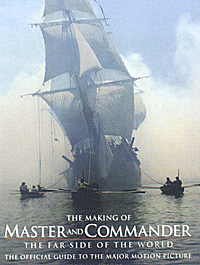Master and Commander
Collected Works
The Making of Master and Commander
by Paul Chamberlain, UK
| |
The film Master and Commander has
generated a number of associated books, linking the film to the naval
history of the period. This article presents reviews of a selection of these titles.
This is the official guide to the major
motion picture starring Russell Crowe and
Paul Bettany, and an essential companion for
fans of both the books and the film, explaining
in great detail how the stories were brought to
life on the big screen.
It explains how the idea for the film came
about and how and why the film story was
adapted from the 10th book in Patrick
O達rian痴 series, the middle story entitled The Far Side of the World, to show the Jack
Aubrey/Stephen Maturin relationship when
they had been friends for some time. The story
was also chosen so that the characters could be
placed on one of the long sea voyages that
feature in the books. O達rian痴 story is set in
1812 with the action against an American
ship.
In the film, the enemy was changed from
American to French to make it more comprehensible
to a general audience. In the novels,
Patrick O達rian emphasised human relationships
and how people treat each other, set
against a vivid background of politics, language,
recreation, diet, science and even furniture,
with the lesser characters being just a
conspicuous as the main ones. This broad
theme was incorporated into the film.
The Making of Master and Commander
explains how the film was made, from a general
idea to the actual production methods. Two ships
were used for the Surprise: one sea going and
one in a water tank at Baja, California; the same
tank in which the Titanic met her iceberg. Much
of the film (especially the storm sequences) was
generated by computer.
Each phase of the story is generously illustrated with stills from the film
or pictures taken during the production process.
Interspersed with this text are sections analysing
the story and relating the historical background.
Painstaking research was done not only on the
ship and the uniforms, but even down to the
spectacles worn by Stephen Maturin, or the cutlery
used by Jack at the meal table. This is the
story of the art of the filmmaker and how the
detailed historical research is translated into an
impressive piece of entertainment.
The entire cast attended lectures on the
naval life of the period, presented by historical
consultants such as Brian Lavery, Peter Goodwin
and Mick Crumplin. What is evident from
this book is the fantastic amount of historical
accuracy that went into every aspect of the
ship, equipment and crew, and how this was
imparted to the cast, to get them familiar with
the period. One example of such detail is the
thrum cap worn by the carpenter on board the
Surprise, a unique and accurate item of clothing
for such a man on board.
Interviews with the cast members provide interesting views on
the making of such a film. A section on
Patrick O達rian reveals much similarity between
him and his character Stephen Maturin.
The Making of Master and Commander
provides much historical information relating
to the period, and relates this to the production
of an impressive film. While some may not
like to know of the technicalities behind such
a production, preferring to view the film as a
piece of historical escapism, this book is a
valuable companion to the Patrick O達rian
novels. The film Master and Commander is a
lasting testimony to some great naval fiction,
and the book superbly compliments both the
books and the film. Highly recommended for
film buffs and followers of the Aubrey/Maturin adventures.
Master and Commander: Collected Works Book Reviews
|
 Tom McGregor
Tom McGregor